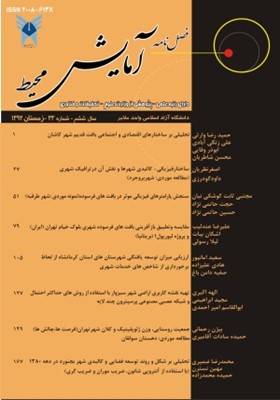هیه نقشه کاربری اراضی شهر سبزوار با استفاده از روشهای حداکثر احتمال و شبکه عصبی مصنوعی پرسپترون چند لایه
محورهای موضوعی : آمایش محیطالهه اکبری 1 * , مجید ابراهیمی 2 , ابوالقاسم امیر احمدی 3
1 - (مربی دانشگاه حکیم سبزواری، کارشناسی ارشد سنجش از دور و GIS )
2 - (دانشجوی دکتری ژئومورفولوژی، دانشگاه حکیم سبزواری)
3 - (دانشیار گروه جغرافیای طبیعی، دانشگاه حکیم سبزواری)
کلید واژه: کاربری اراضی شهری, سبزوار, تصویر ماهوارهای, شبکه عصبی پرسپترون چند لایه, ارزیابی دقت,
چکیده مقاله :
از جمله عوامل مهم در برنامهریزی و مدیریت شهری، به ویژه در راستای نیل به توسعهی پایدار در نواحی شهری و استفاده بهینه از سرزمین، اطلاع بهنگام از وضعیّت پوشش اراضی برای این مناطق است. دادههای سنجش از دور به جهت ارائهی اطلاعات به هنگام و رقومی، تنوع اشکال و امکان پردازش پتانسیل بالایی برای تهیهی نقشههای به روز کاربری اراضی شهری دارند. در این تحقیق با استفاده از تصویر ماهوارهای Landsat/ETM+ و دو الگوریتم طبقهبندی نظارت شده شامل حداکثر احتمال و شبکه عصبی مصنوعی، نقشه کاربری اراضی تهیه و با یکدیگر مقایسه گردید. در طبقهبندی با استفاده از الگوریتم شبکه عصبی از یک شبکه پرسپترون با یک لایه پنهان و 7 نرون ورودی، 9 نرون میانی و 4 نرون خروجی استفاده شده است که تعداد نرونهای ورودی همان تعداد باندهای تصویر ماهوارهای لندست و تعداد نرونهای خروجی همان تعداد کلاسهای نقشه کاربری اراضی میباشد. در نهایت نقشه پوشش اراضی منطقه به چهار طبقهی مناطق مسکونی، اراضی بایر، پوشش گیاهی و جادّه طبقهبندی شد. برای ارزیابی صحّت نتایج طبقهبندی، برداشتهای زمینی با استفاده از GPS انجام گرفت. نتایج حاصل از ارزیابی دقت این دو روش با استفاده از صحت کلی و ضریب کاپا نشان داده است که الگوریتم شبکه عصبی پرسپترون با دقت کلی 24/98 و ضریب کاپای 9703/0 نسبت به الگوریتم حداکثر احتمال با دقت کلی 23/94 و ضریب کاپای 9034/0 از دقت بیش تری برخوردار است. همچنین در این تحقیق ارزیابی شد که روش طبقهبندی شبکهی عصبی پرسپترون چند لایه، نسبت به روش حداکثر احتمال، از توان تفکیک و قابلیت بیش تری برای تهیهی نقشه پوشش اراضی در مناطق شهری برخوردار میباشد.
Among the important factors in urban planning and management, particularly in line with the achievement of the sustainable development in the urban areas as well as regarding the optimal use of the land, is on-time access to the data of land cover conditions in these regions. The remote sensing data has a high potential for the preparation of the update urban land cover maps. In order to present on-time and digital satellite data, a variety of shapes and possibility of processing during land cover maps are of high significance. In order to use the satellite photos Landsat/ETM+ and two algorithm of supervised classification including the maximum likelihood and the artificial neural network, land cover maps were prepared. During classification, the neural network algorithm of a perceptron network with a hidden layer and 7 input neurons, nine middle neurons and 4 output neurons were used. The input neurons are the same in number as the bands of the Landsat photos and the number of output neurons are the same as land cover map classes. Eventually, land cover map of the region has been classified into four classes of residential areas, barren lands, plant coverage, and roads. In order to evaluate the correctness of the classification results, many photos have been taken using GPS. Using overall accuracy and Kappa Coefficient the precision evaluation results of these two methods indicate that perceptron neural network has an overall accuracy of 98/24 and Kappa Coefficient 97/03 compared to the algorithm of maximum likelihood with an overall accuracy of 94/23 and Kappa Coefficient 90 / 34 is of higher precision. The findings of this study also show that the classification method for multilayer perceptron neural network as compared with the maximum likelihood method is of higher separation and capability for preparing the land cover map in the urban regions.
_||_

